All Americans should be concerned about the Israel-Hamas war: Pastor John Hagee
Cornerstone Church Pastor John Hagee discusses his efforts to combat antisemitism on 'Life, Liberty & Levin.'
Israel’s first war with neighboring Arab countries began on the same day the Jewish state was re-established on May 14, 1948. While Jewish sovereignty ended 2,000 years earlier, in the year 70 A.D. at the hands of the Roman conquest, there has been a continuous Jewish presence in the land throughout. The first Jewish commonwealth dates back 3,000 years to the time of King David.
That war saw surrounding Arab nations – Egypt, Syria, Lebanon, Transjordan and Iraq, (with additional forces sent by Saudi Arabia and Yemen) –attack the fledgling state. The war led to the displacement of some 750,000 Arabs. At the same time, Arab nations began expelling hundreds of thousands of their Jewish populations, many of whom would settle in Israel.
Today’s war in Gaza is a continuation of the many wars and conflicts that have ensued since. Here is a timeline of the Israeli-Arab conflict:
November 1947
A majority of United Nations member states vote in the General Assembly on a partition plan to divide British Mandated Palestine into a Jewish state and an Arab state. While the Jews accepted the plan for two states, the Arabs rejected it.
May 1948
Israel proclaimed independence, re-establishing the modern Jewish state and was immediately attacked by a coalition of Arab states, the first of a series of Arab-Israeli wars. Against all odds, the Israelis fight off the Arab armies in the War of Independence.
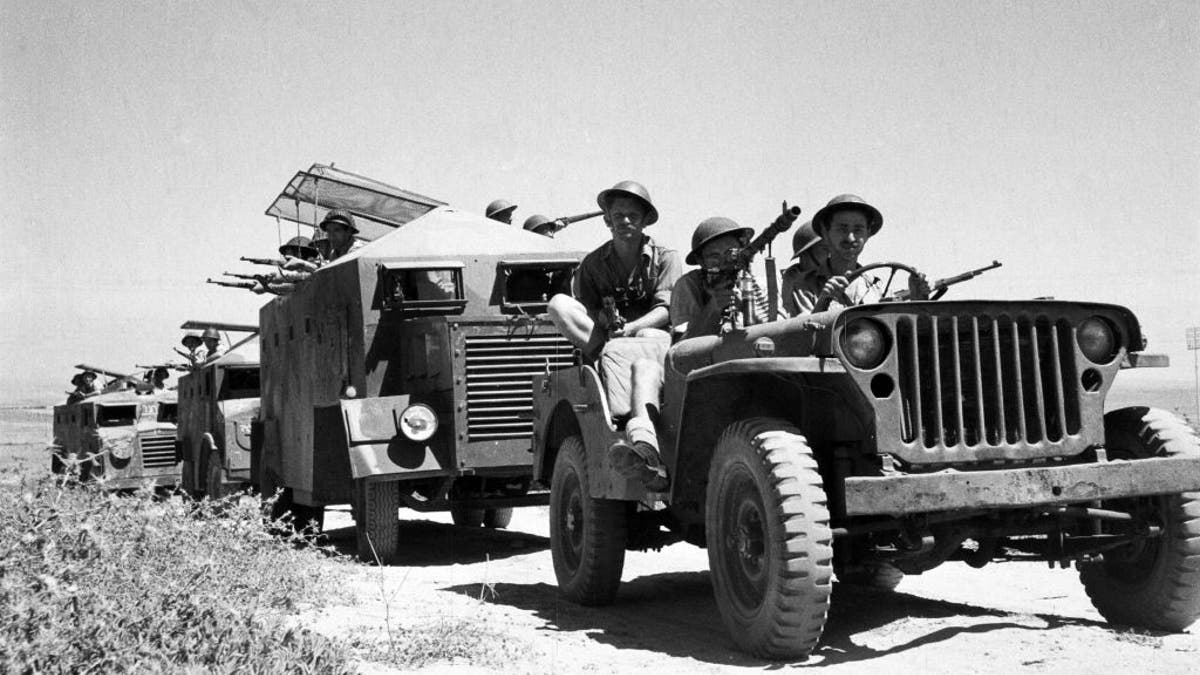
A force of Israeli Palmach armored cars in the Negev Desert, Arab-Israeli War, 1948. (History/Universal Images Group via Getty Images)
October 1956
Egypt's President Gamal Abdel Nasser nationalizes the Suez Canal, which would result in Israeli, British and French military action. The French and Brits wanted to depose Nasser while Israel wanted to regain access through the Straits of Tiran. An agreement facilitated by the U.S. and Soviet Union resolved the conflict, but the canal remained closed until 1957 due to sunken ships. Nasser remained in power.
May 1964
In 1964, some three years before Israel took over territory won in the 1967 war, the Palestine Liberation Organization (PLO) was formed, as well as additional smaller groups, calling for a return to what they consider their homeland. Their aim was the destruction of the State of Israel. Buoyed on by its leader Yasser Arafat, the PLO launched deadly terror attacks against Israel.

Israeli soldiers celebrate at the Western Wall, June 9, 1967, in Jerusalem, after Israeli troops defeated Jordan in the city. (AFP via Getty Images)
May 1967
Egypt’s Nasser tells the United Nations that its peacekeeping force needs to leave the Sinai, with the aim of making it easier to attack Israel. Egypt once again blocks off the Straits of Tiran, which Israel viewed as an act of war.
IRANIANS ARE ISRAELIS' 'GREATEST DEFENDERS' DESPITE REGIME'S PRAISE OF HAMAS: ISRAELI JOURNALIST
June 1967
Not wasting any time, the Israelis launched a surprise attack in what would be known as the Six-Day War.
As a result, Israel seizes control of the Gaza Strip, the Sinai, the West Bank, (known by Israelis as Judea and Samaria), the Golan Heights, and Jordanian-controlled East Jerusalem, thereby fulfilling the millennia-long Jewish dream of unifying the holy city as the capital of the Jewish state. Israel's victory against the Arabs was hailed as one of the most significant victories in military history.
1967-1970
Following the Six-Day War, with no serious peace agreement reached between the warring parties, the fighting between Israel and Arab nations continued, evolving into a three-year War of Attrition.
The tension is underscored by the Three No's declaration made by the Arab League in September 1967 in Khartoum, Sudan: No peace, No recognition, and No negotiations with Israel.
October 1973
Arab nations, led by Egypt and Syria, launch a surprise attack on Israel on the holiest day of the year for the Jewish people, Yom Kippur. The initial Arab advance is met with a strong Israeli counteroffensive. The conflict resulted in heavy casualties on both sides, with Israel fighting back and winning a decisive victory. President Nixon ordered a mass airlift of tanks, ammunition and equipment that is credited with making a big difference in aiding Israel to win the war.
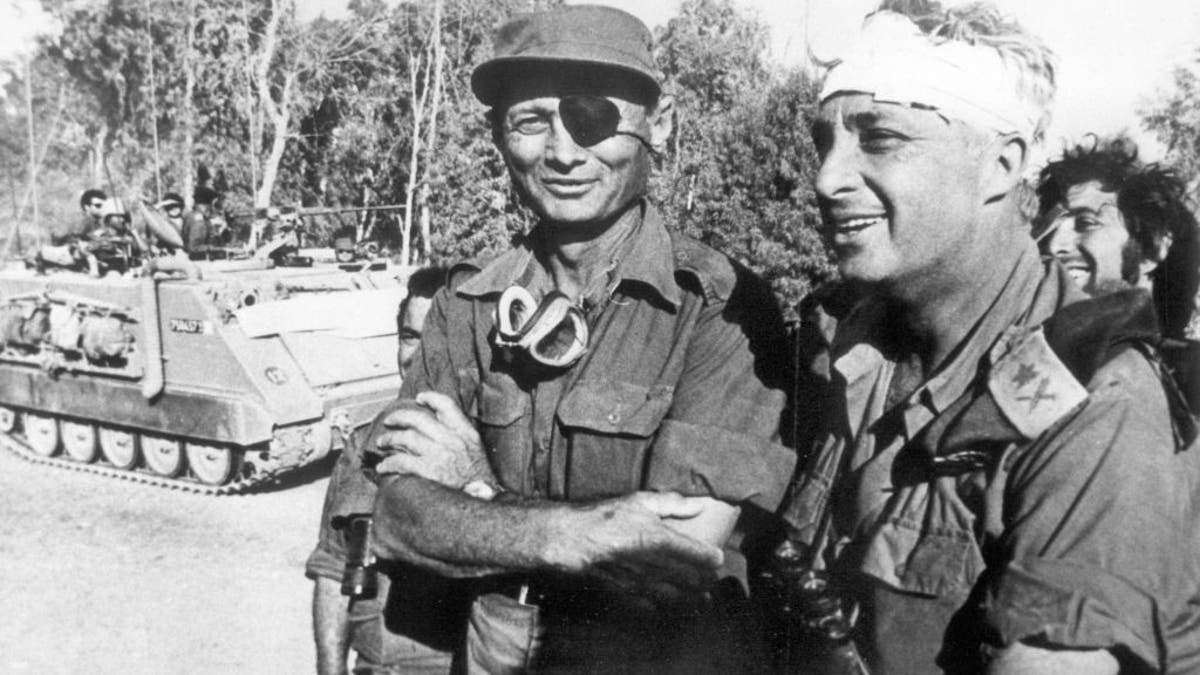
Israeli Defense Minister and General Moshe Dayan, left, with Maj. Gen. Ariel Sharon, wearing a head bandage, on the Egyptian side of the Suez Canal during the fourth Israeli-Arab War. (UPI/dpa (Photo by UPI/picture alliance via Getty Images)
September 1978
The Camp David Accords, brokered by U.S. President Jimmy Carter in 1978, laid the groundwork for a subsequent peace agreement between Egypt's President Anwar Sadat and Israel's Prime Minister Menachem Begin.
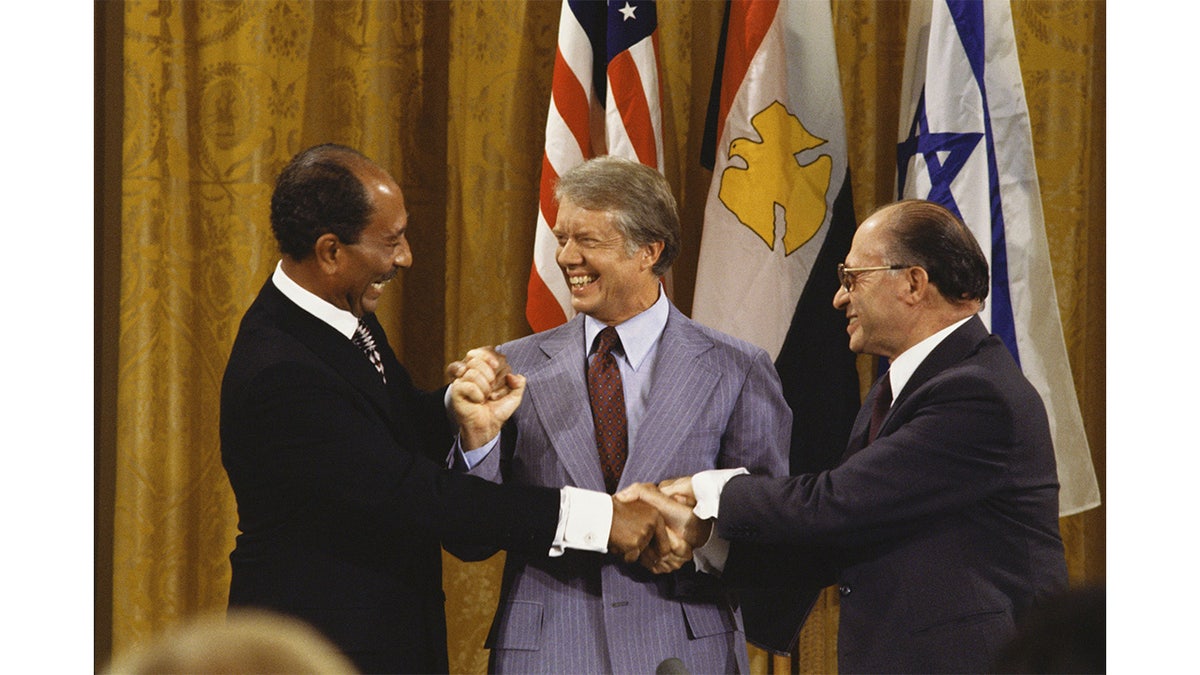
Egyptian President Anwar Sadat, President Jimmy Carter and Israeli Prime Minister Menachem Begin join hands after the Camp David Accords, Sept. 18, 1978, in the East Room of the White House in Washington, D.C. (David Hume Kennerly/Getty Images)
1979
Ayatollah Khomeini seizes power in Iran’s Islamic revolution, paving the way for a new hostile power. The regime holds 98 Americans hostage for 444 days after protesters stormed the U.S. embassy in Tehran. The Iranian regime refers to the U.S. as the Great Satan and Israel the little Satan and starts a campaign of terror against U.S. and Israeli interests.
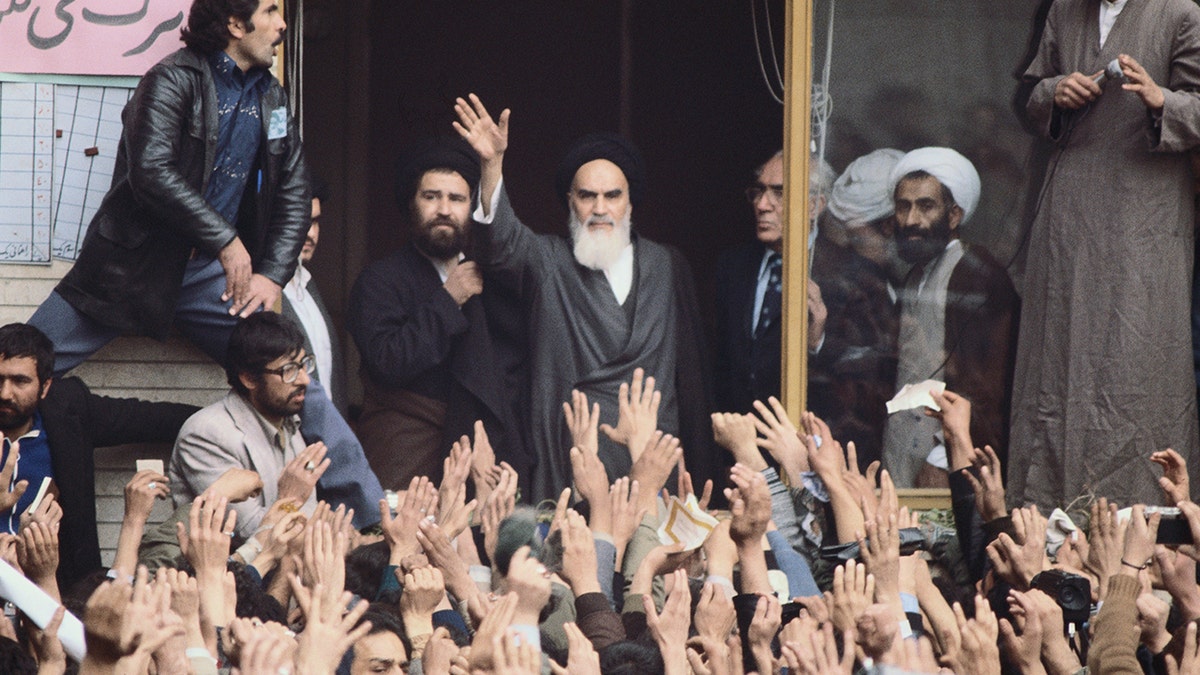
Ayatollah Khomeini waves to a crowd of enthusiastic supporters on his return to Tehran. (Michel Setboun/Corbis via Getty Images)
June 1982
The first Lebanon war was launched by Israel to stop Palestinian terrorists attacking communities in northern Israel. The decision to invade Lebanon followed the attempted assassination of Israel's ambassador in London by Palestinian terrorists. The war lasted more than three months, with Israeli troops reaching as far as the outskirts of Beirut, leading to the exodus of thousands of PLO members, including Arafat.
September 1982
Despite the withdrawal of the PLO from Lebanon, Israeli troops continued to monitor activities in Lebanon. On Sept. 16, in coordination with the Israeli army, a Lebanese Christian militia group known as the Phalange enters two Palestinian refugee camps, Sabra and Shatila. The Phalange mission was to wipe out terrorists in the camps, but instead they killed many civilians in a notorious massacre.
Reports vary on the number of people killed, from 460 to 3,500. Israel held a commission of inquiry following outrage from the Israeli public and found that Israel was partly responsible for the massacre. It also resulted in the firing of the IDF chief of staff and led to the resignation of then Defense Minister Ariel Sharon.
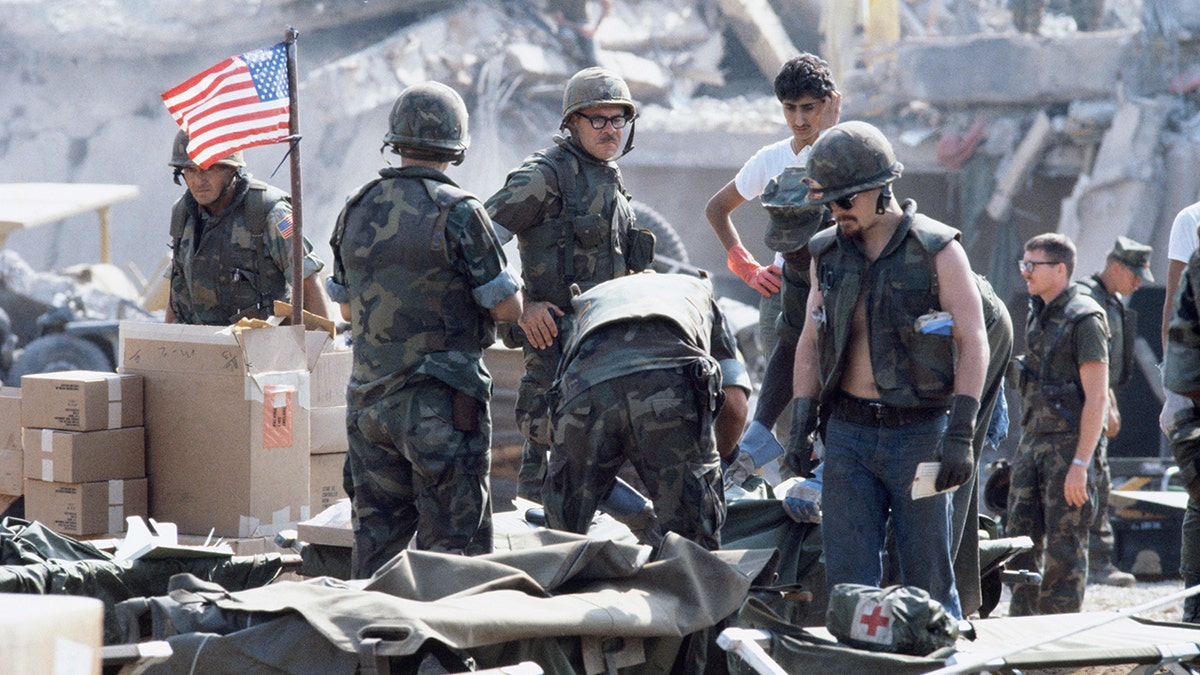
American Marines search for survivors and bodies in the rubble, all that was left of their barracks headquarters in Beirut, after a terrorist suicide car bomb killed 241 U.S. servicemen and wounded over 60. (Peter Charlesworth/LightRocket via Getty Images)
1983
A suicide bomber kills 241 U.S. servicemen, mostly Marines, after an Iran directed terror attack carried out by Hezbollah targeted the U.S. Marine barracks in Beirut. The U.S. was there as part of a multinational peacekeeping force. Shortly after the attack, a French peacekeeping mission was also targeted, killing 58 French paratroopers.
Israel maintains its occupation zone in southern Lebanon after pulling back from a line further north, controlling the area with the help of the South Lebanon Army.
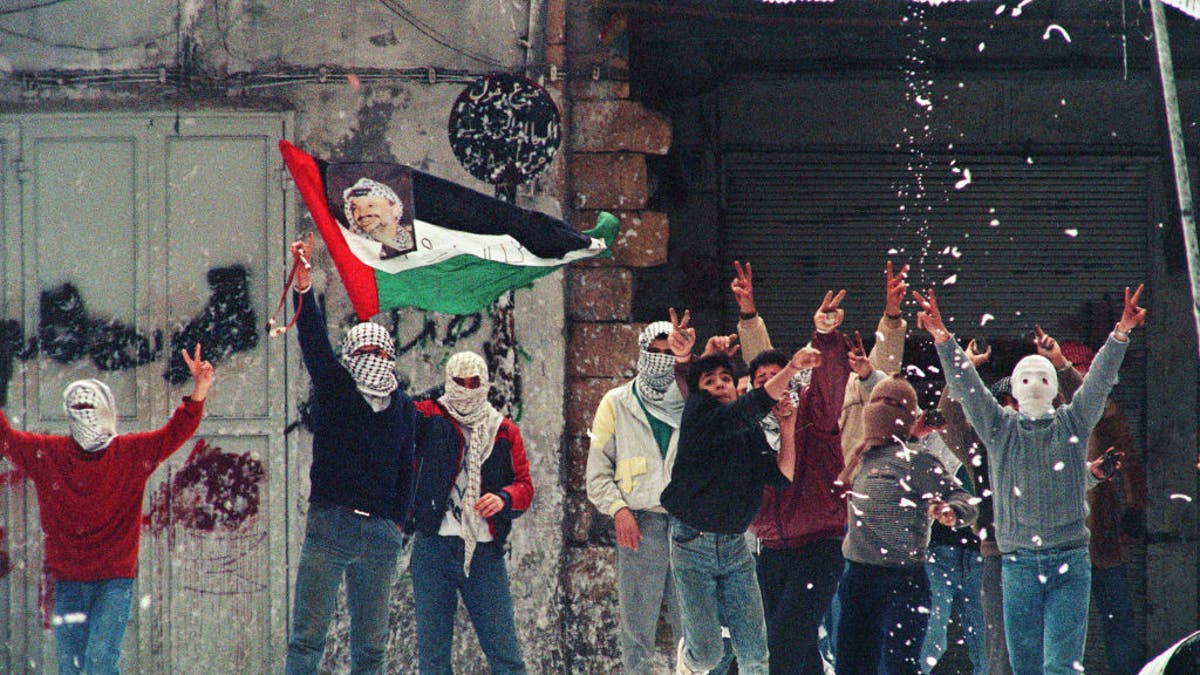
Several Palestinian demonstrators hold a Palestinian flag with a portrait of PLO leader Yasser Arafat as foam thrown by Israeli soldiers drops from a roof during clashes Jan. 22, 1988, in Nablus on the West Bank. (Sven Nackstrand/AFP via Getty Images)
December 1987
Palestinians launched a national uprising, known as the Intifada, against Israel’s occupation of the West Bank and Gaza. This leads to a heavy Israeli military crackdown, resulting in clashes and many casualties on both sides.
Hamas is founded around the same time of the first Intifada in 1987. According to The Associated Press, the acronym for Hamas in Arabic is "the Islamic Resistance Movement," in recognition of its ties to the Muslim Brotherhood. The terror group’s founding charter calls for the destruction of the Jewish state.
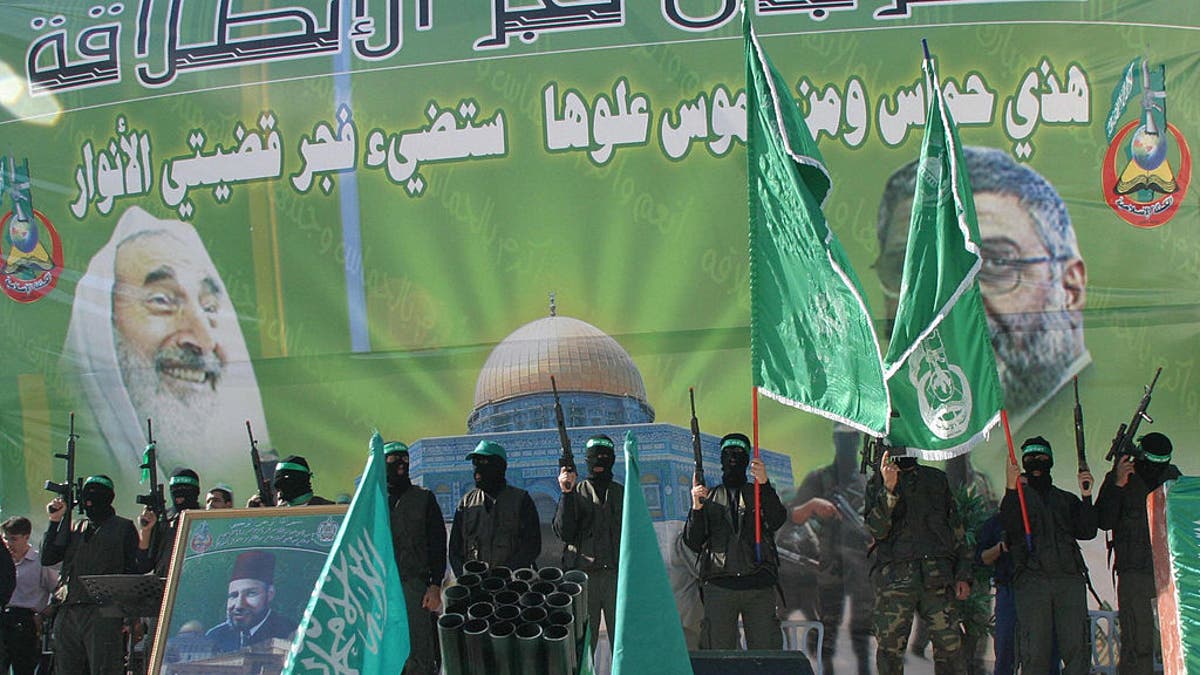
Standing in front of portraits of assassinated Hamas leaders, masked Hamas terrorists celebrate the 18th anniversary of the founding of the Islamic movement at Hebron University in the West Bank, Dec. 14, 2005. (Hazwm Bader/AFP via Getty Images)
FATHER SPEAKS OUT AS SON REMAINS MISSING IN ISRAEL
September 1993
The Oslo Accords, consisting of two key agreements, were signed between Israel and the Palestine Liberation Organization (PLO). These agreements lay the groundwork for limited Palestinian self-rule in the West Bank and Gaza Strip, establishing the Palestinian Authority to manage administrative affairs in some areas. The PLO also agreed to renounce violence and recognize the Jewish state.
While the PLO gains recognition as a negotiating partner from Israel and the United States, critical issues like Israeli settlements in the West Bank and the status of Jerusalem, which Palestinians hope will become their future capital, remain unresolved.

President Bill Clinton stands between PLO leader Yasser Arafat and Israeli Prime Minister Yitzahk Rabin as they shake hands for the first time, Sept. 13, 1993, at the White House after signing the Oslo Accords. (J. David Ake/AFP via Getty Images)
November 1995
On Nov. 4, as progress toward peace between Israelis and Palestinians continues, Israeli Prime Minister Yitzhak Rabin was assassinated at a peace rally in Tel Aviv by ultranationalist Israeli Yigal Amir, who opposes the Oslo Accords.
April 1996
Following increased rocket attacks on its civilian communities in the north by Shiite terrorist group Hezbollah in Lebanon, Israel launched "Operation Grapes of Wrath," to deter the attacks.

Hezbollah members hit their heads during the funeral for four of their fighters in Majdel Zoun, south of Tyre, on April 28, 1996. (Joseph Barrak/AFP via Getty Images)
October 1997
The Clinton State Department proscribes Hamas as a Foreign Terrorist Organization (FTO.) Other countries follow with their own designations of the group.
May 2000
Israel completes its full withdrawal from Southern Lebanon.
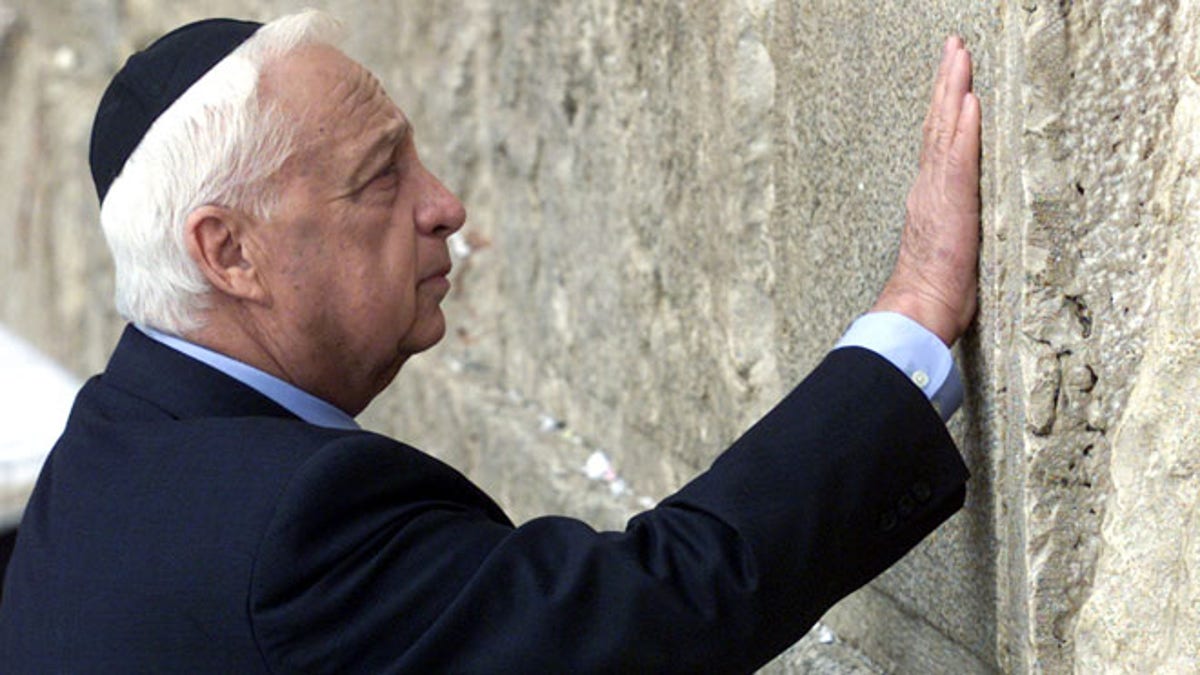
Prime Minister-elect Ariel Sharon touches the stones of the Western Wall as he prays while visiting the holy site, Feb 7, 2001. (Reuters)
September 2005
In January 2005, Prime Minister Ariel Sharon announced Israel's unilateral withdrawal from Gaza, overseeing a full disengagement from the Palestinian enclave in September of that year. The following year, Hamas wins legislative elections, creating political tensions with Fatah in the West Bank. Elections have not taken place since then.

A young Jewish girl with an Israeli flag cries out during the withdrawal from the Gaza Strip on Aug. 18, 2005, in the Neve Dekalim settlement. (Kitra Cahana/Getty Images)
July 2006
Iranian-backed terror group Hezbollah kidnaps two Israeli soldiers and kills an additional eight, sparking the Second Lebanon War. Hezbollah fires thousands of rockets and missiles into northern Israel, which responds with airstrikes and ground forces. Following hundreds of deaths and massive damage on both sides, hostilities come to an end with the passage of U.N. Security Council Resolution 1701.
June 2007
In 2007, Hamas forcefully took control of Gaza, overthrowing the Palestinian Authority in the strip. In response to Hamas rockets launched from Gaza, Israel imposed a partial blockade on the enclave by controlling goods and personnel coming in and out of the territory.

Hamas members ride an armored vehicle siezed from Fatah during a celebration rally June 15, 2007, in Gaza City, Gaza Strip. (Abid Katib/Getty Images)
December 2008/2009
Israel launched "Operation Cast Lead" aimed at stopping Hamas rocket and mortar fire from the territory into Israel.
November 2012
Israel killed Hamas terror leader Ahmed Jabari, triggering a week-long period of rocket attacks from Gaza and retaliatory Israeli airstrikes. The conflict resulted in at least 150 Palestinians and six Israelis losing their lives.

Exiled Hamas leader Khaled Mashaal in Moscow on Feb. 9, 2010. (Oxana Onipko/AFP via Getty Images)
The highly controversial chant that is seen as calling for Israel's destruction, "From the river to the sea," is adopted by Hamas, according to The Associated Press. Kahled Mashaal, the group's former leader, stated in a speech celebrating the terrorist group's 25th anniversary that, "Palestine is ours from the river to the sea and from the south to the north… There will be no concession on any inch of the land." Other reports say the slogan originated in the 1960s and was used by the PLO.
Summer 2014
Hamas terrorists kill three Israeli teenagers abducted in the vicinity of a Jewish settlement in the West Bank. As Israel attempted to save the teens, Hamas fired hundreds of rockets into Israel, leading to an incursion by Israeli forces into Gaza. The conflict, which Israelis refer to as Operation Protective Edge, lasted 50 days and resulted in more than 2,200 Palestinian fatalities in Gaza and 73 Israeli deaths.

Israeli soldiers fire a 155mm self-propelled howitzer toward targets in the Gaza Strip from their position near the southern Israeli city of Sderot, May 12, 2021. (Menahem Kahana/AFP via Getty Images)
ISRAELI FORCES ENTERED GAZA FOR LOCALIZED RAIDS, IDF TELLS FOX NEWS
March 2018
Violent protests unfold along the Gaza-Israel border, as Gazans tried to break through the security fence in what they term as the "Great March of Return," endangering Israeli communities on the border. The IDF responds with sniper fire, killing some 190 protesters over the course of several months.

Israeli forces intervene during Palestinians' "Great March of Return" near Gaza-Israel border in Khan Yunis, Gaza, on Dec. 21, 2018. (Ashraf Amra/Anadolu Agency/Getty Images)
In November, Israel executes a raid into Gaza, resulting in the loss of at least seven Palestinian terrorists and a high-ranking Israeli army officer. In retaliation, hundreds of rockets are launched from Gaza into Israeli territory.
MAY 2018
The Trump administration fulfills an election promise and recognizes Jerusalem as the capital of Israel and opens up its new embassy in the holy city.

Ivanka Trump and Treasury Secretary Steven Mnuchin at the opening of the U.S. Embassy in Jerusalem. (AP)
President Trump said in a video statement, "For many years, we have failed to acknowledge the obvious, plain reality that the [Israeli] capital is Jerusalem. At my direction, the United States finally and officially recognized Jerusalem as the true capital of Israel."
September 2020
The UAE and Bahrain normalize ties with Israel in agreements known as the Abraham Accords. The historic Trump administration-brokered accords followed months of negotiations. Sudan and Morocco also sign normalization agreements with Israel. Palestinian leader Mahmoud Abbas and Hamas reject the accords.

From left, Foreign Affairs Minister of Bahrain Abdullatif bin Rashid Al Zayani, Prime Minister of Israel Benjamin Netanyahu, President Donald Trump and Foreign Affairs Minister of the United Arab Emirates Abdullah bin Zayed bin Sultan Al Nahyan participate in the signing ceremony of the Abraham Accords at the White House, Sept. 15, 2020. (Alex Wong/Getty Images)
May 2021
Following weeks of heightened tension in Jerusalem, Israeli police responded to violence on the Temple Mount, the most sacred site to Jews, and the site of the al-Aqsa Mosque, one of Islam's most revered sites. In response, Hamas launched thousands of rockets into Israel, triggering retaliation involving hundreds of airstrikes in the most intense conflict since at least 2014, with many deaths on both sides.
January 2023
Israeli military units conduct anti-terror raids into the Palestinian city of Jenin, resulting in a deadly shootout that kills nine terrorists. The following day, a Palestinian terrorist opens fire at a Jerusalem synagogue during prayer, killing seven people, including children.
Summer 2023
In May, Israel launched surprise airstrikes in Gaza, leading to a five-day conflict that caused casualties on both sides.
In June, Israeli forces conduct a significant raid into Jenin due to an increasing wave of terrorism coming from Iran-backed terror groups from within the Palestinian city.
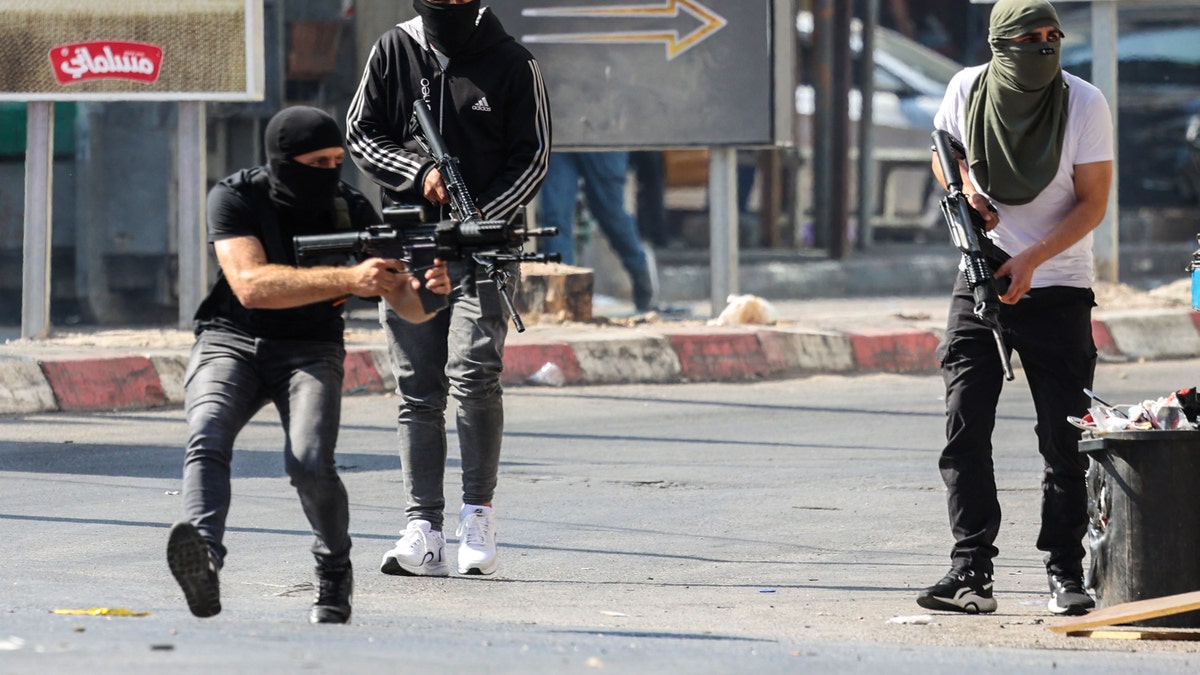
Palestinian terrorists take up position during a confrontation with Israeli soldiers in Jenin on July 3, 2023. (Jaafar Ashtiyeh/AFP via Getty Images)
Following lethal terror attacks on Israelis, extremist Jewish settlers clashed with Palestinians in their villages. Israel subsequently executes its first drone strike in the West Bank since 2006, targeting terrorist headquarters.
The following month, Israel initiated an air and ground offensive targeting terrorists within Jenin, marking the start of a prolonged "comprehensive counterterrorism effort."

Israeli tanks move toward the Gaza Strip border in southern Israel. (AP/Ohad Zwigenberg)
October 2023
On Oct. 7, Hamas terrorists surprised Israel in a brutal attack by invading its communities along the Gaza border. Some 1,200 Israelis were savagely killed, with 240 Israelis and foreigners kidnapped and taken hostage in Gaza.

Split image of Hamas terrorists with civilian body bags. (Yousef Masoud/Majority World/Universal Images Group and Amir Levy/Getty Images)
On Oct. 8, Prime Minister Benjamin Netanyahu officially declared war on Hamas. The offensive occurs a day after the 50th anniversary of the 1973 Yom Kippur War.
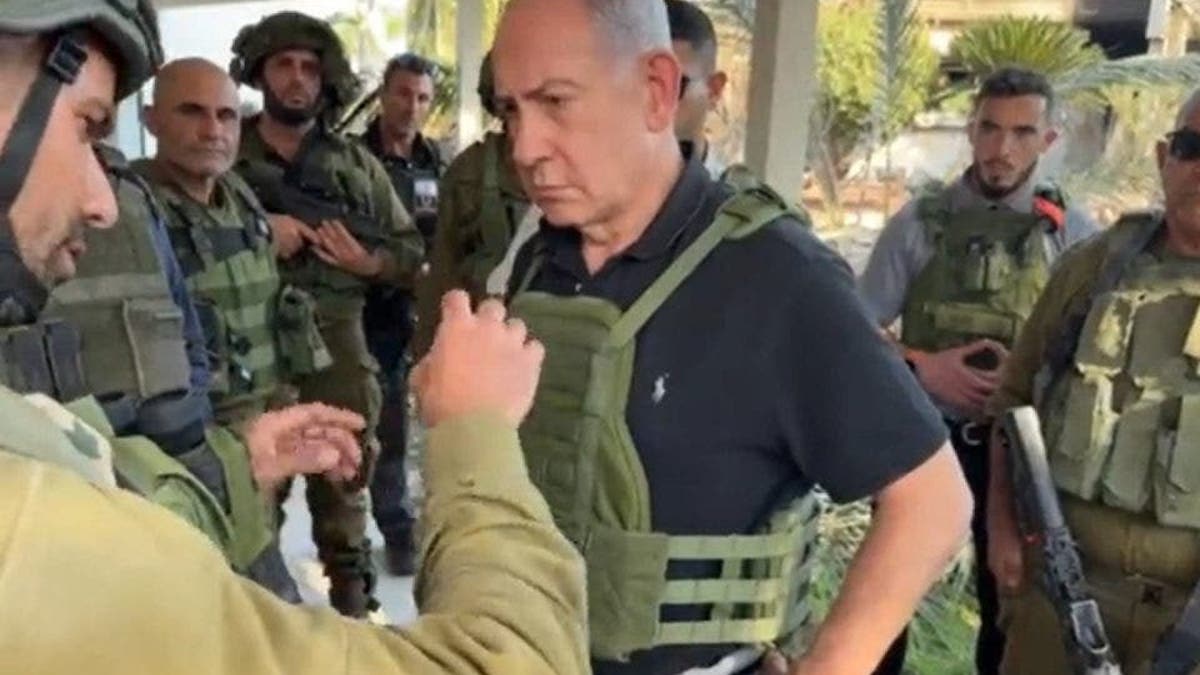
Israeli Prime Minister Benjamin Netanyahu meets with Israeli Defense Force soldiers on the front lines ahead of the initial ground invasion. (Benjamin Netanyahu - @netanyahu)
CLICK HERE TO GET THE FOX NEWS APP
The Israeli Air Force commences attacks against Hamas targets in Gaza, responding to the infiltration by Hamas terrorists into Israeli territory from the Gaza Strip. Israel has responded with a significant series of airstrikes targeting terrorists in Gaza and a ground incursion into Gaza. The Hamas-controlled ministry of health has claimed 12,000 Palestinians have been killed as a result of Israeli attacks.

Israel's military has said it has divided Gaza into two parts – North Gaza and South Gaza – as it roots out Hamas terrorists from the territory. (IDF)
The United States and many other countries have expressed support for Israel's ongoing war against Hamas terror.
Fox News' Chris Massaro, The Associated Press and Reuters contributed to this report.





















